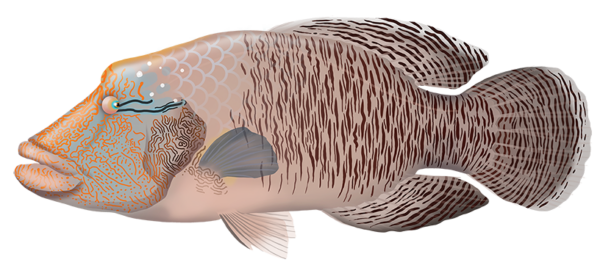Quick Facts
Distribution

Interesting Info
- The Humphead Maori Wrasse can be found in various regions along the northern coasts of Australia, including the Great Barrier Reef, Coral Sea, and other reefs in Western Australia and the Northern Territory.
- Humphead Maori Wrasse are characterised by their large, thick lips and a prominent hump on their forehead, which gives them their common name. They have a robust, elongated body with a dark blue or green coloration on the upper side and a lighter shade on the lower side.
- They are a carnivorous species, with their diet consisting of hard-shelled invertebrates such as molluscs, crustaceans, and echinoderms. They have powerful jaws and specialised teeth that allow them to crush and consume these prey items. Additionally, they also feed on smaller fish and occasionally graze on algae.
- Despite being predominantly sedentary and territorial, Humphead Maori Wrasse have been observed undertaking long-distance movements. Studies have shown that individuals can travel significant distances, up to several hundred kilometres, between different reef systems.
- They are known to produce distinctive grunting sounds. These sounds are thought to be a form of communication between individuals and are used for territorial defence or during courtship displays.
- Humphead Maori Wrasse are protogynous hermaphrodites, meaning they start their lives as females and can transition to males later in life. They typically breed during the summer months, between December and March, when water temperatures are warmer. During breeding season, males undergo a vibrant colour change, displaying a vivid blue-green hue.
- Their estimated average lifespan is between 30 – 40 years. There are reports of them living up to 60 years.
Species Interaction
Recreational Fishing, Snorkeling & Diving
The Humphead Maori Wrasse is not typically targeted for recreational fishing in Australia. Due to their protected status and conservation concerns, there are strict regulations in place to limit the harvesting of this species. When caught they should be released. They are highly sought-after by snorkelers and divers due to their impressive size, striking appearance, and relatively approachable behaviour. They can be a thrilling sight to encounter underwater.
Scientific Classification
Kingdom: Animalia
Phylum: Chordata
Class: Actinopterygii
Order: Perciformes
Family: Labridae
Genus: Cheilinus
Species: Cheilinus Undulatus
Conservation Status
In Australia, the Humphead Maori Wrasse is listed as a protected species under the Environment Protection and Biodiversity Conservation Act 1999 (EPBC Act). They are classified as “Vulnerable” by the International Union for Conservation of Nature (IUCN) due to various threats, including overfishing and habitat degradation.
How to catch
Humphead Maori Wrasse
Catch Difficulty: Difficult
Tackle: Running Sinker Rig
Bait: Crab, Fresh cut flesh baits, Prawns, Squid, Worms
Technique: Keep bait close to the reef/structure
Popularity: Not targeted
Recreational Viewing
- Snorkeling & Scuba
Finding: Easy
Temperament: Curious
Location: Inner Reef, Outer Reef, Lagoon
Danger: None





